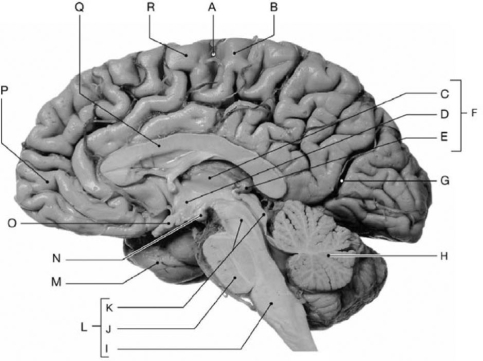A) frontal lobe.
B) postcentral gyrus.
C) hippocampus.
D) parietal lobe.
E) thalamus.
Correct Answer

verified
Correct Answer
verified
Multiple Choice
An autonomic motor neuron whose cell body lies in the CNS is called a(n)
A) upper motor neuron.
B) lower motor neuron.
C) preganglionic neuron.
D) postganglionic neuron.
E) somatic motor neuron.
Correct Answer

verified
Correct Answer
verified
Multiple Choice
The ________ is the layer of the meninges that is in direct contact with the surface of the brain.
A) pia mater
B) subarachnoid space
C) dura mater
D) epidural space
E) arachnoid
Correct Answer

verified
Correct Answer
verified
Multiple Choice
 Photo Credit: Ralph T. Hutchings
Figure 8-1 Structural Components of the Brain (Sagittal Section)
Use Figure 8-1 to identify the labeled part.
-Structure E is the
Photo Credit: Ralph T. Hutchings
Figure 8-1 Structural Components of the Brain (Sagittal Section)
Use Figure 8-1 to identify the labeled part.
-Structure E is the
A) hypothalamus.
B) thalamus.
C) midbrain.
D) pituitary gland.
E) pineal gland.
Correct Answer

verified
Correct Answer
verified
Multiple Choice
Postganglionic fibers of autonomic neurons are usually
A) connected to cardiac muscle, smooth muscle, glands, and adipocytes.
B) short in length.
C) originating as nerves from the brain.
D) located in the brain.
E) located in the spinal cord.
Correct Answer

verified
Correct Answer
verified
Multiple Choice
 Photo Credit: Ralph T. Hutchings
Figure 8-1 Structural Components of the Brain (Sagittal Section)
Use Figure 8-1 to identify the labeled part.
-Structure A is the
Photo Credit: Ralph T. Hutchings
Figure 8-1 Structural Components of the Brain (Sagittal Section)
Use Figure 8-1 to identify the labeled part.
-Structure A is the
A) lateral sulcus.
B) transverse fissure.
C) longitudinal fissure.
D) central sulcus.
E) central gyrus.
Correct Answer

verified
Correct Answer
verified
Multiple Choice
You have been diagnosed with the demyelinating disease called multiple sclerosis. The areas of damage seem to be centered within the spinal cord. The demyelinated areas are most probably within the
A) ascending and/or descending tracts.
B) dorsal or ventral horns.
C) central canal.
D) dorsal root ganglia.
E) gray commissure.
Correct Answer

verified
Correct Answer
verified
Multiple Choice
Which of the following performs such abstract intellectual function as predicting the future consequences of events or actions?
A) pons
B) basal ganglia
C) hippocampus
D) thalamus
E) prefrontal cortex
Correct Answer

verified
Correct Answer
verified
Multiple Choice
Which structure contains cardiovascular and respiratory rhythmicity centers?
A) inferior colliculus
B) superior colliculus
C) pons
D) cerebellum
E) medulla oblongata
Correct Answer

verified
Correct Answer
verified
Multiple Choice
Which of the following is a function of the efferent division of the nervous system?
A) providing sensation of the internal and external environments
B) integrating sensory information
C) coordinating voluntary and involuntary activities
D) sending signals to muscles
E) regulating or controlling peripheral structures and systems
Correct Answer

verified
Correct Answer
verified
Multiple Choice
Which of the following pairs is not properly matched?
A) cervical spinal nerves: 8
B) thoracic spinal nerves: 12
C) lumbar spinal nerves: 4
D) sacral spinal nerves: 5
E) coccygeal spinal nerves: 1
Correct Answer

verified
Correct Answer
verified
Multiple Choice
Which pathway provides subconscious, involuntary control of muscle tone and movements of the neck, trunk, and limbs?
A) spinothalamic
B) spinocerebellar
C) homuncular
D) medial pathway
E) posterior column
Correct Answer

verified
Correct Answer
verified
Multiple Choice
Which spinal cord structure(s) contains the axons of CNS motor neurons that control muscles and glands?
A) anterior gray commissure
B) white column
C) ventral roots
D) dorsal roots
E) ventral horns
Correct Answer

verified
Correct Answer
verified
Multiple Choice
Which nerve innervates the diaphragm?
A) musculocutaneous
B) obturator
C) axillary
D) saphenous
E) phrenic
Correct Answer

verified
Correct Answer
verified
Multiple Choice
 Photo Credit: Ralph T. Hutchings
Figure 8-1 Structural Components of the Brain (Sagittal Section)
Use Figure 8-1 to identify the labeled part.
-Structure L is the
Photo Credit: Ralph T. Hutchings
Figure 8-1 Structural Components of the Brain (Sagittal Section)
Use Figure 8-1 to identify the labeled part.
-Structure L is the
A) midbrain.
B) forebrain.
C) cerebellum.
D) basal ganglia.
E) brainstem.
Correct Answer

verified
Correct Answer
verified
Multiple Choice
The sensory nuclei of cranial nerves V-VIII are found within which of the following?
A) midbrain
B) medulla oblongata
C) cerebellum
D) basal ganglia
E) pons
Correct Answer

verified
Correct Answer
verified
Multiple Choice
Which structures are related to Parkinson's disease?
A) the reticular formation and limbic system
B) the basal nuclei and the midbrain
C) the hypothalamus and thalamus
D) the thalamus and pineal gland
E) the hippocampus and amygdala
Correct Answer

verified
Correct Answer
verified
Multiple Choice
The phrenic nerves arise from the
A) cervical plexus.
B) thoracic plexus.
C) lumbar plexus.
D) sacral plexus.
E) brain.
Correct Answer

verified
Correct Answer
verified
Multiple Choice
Enlargements of the spinal cord occur
A) near the posterior median sulcus.
B) adjacent to the anterior median fissure.
C) in the cervical and lumbar regions.
D) in the thoracic region of the spinal cord.
E) in the cervical and thoracic regions.
Correct Answer

verified
Correct Answer
verified
Multiple Choice
Regions of the brain that are involved in interpreting data or coordinating motor responses are
A) commissural areas.
B) sensory areas.
C) association areas.
D) motor areas.
E) processing areas.
Correct Answer

verified
Correct Answer
verified
Showing 21 - 40 of 149
Related Exams